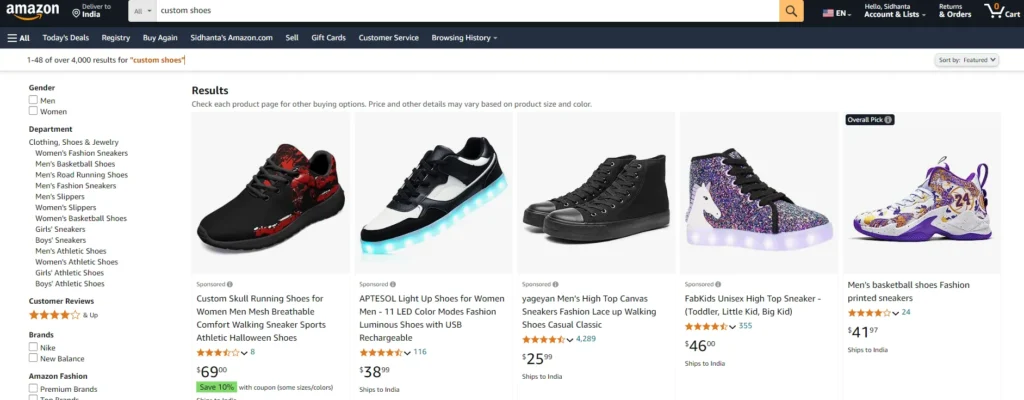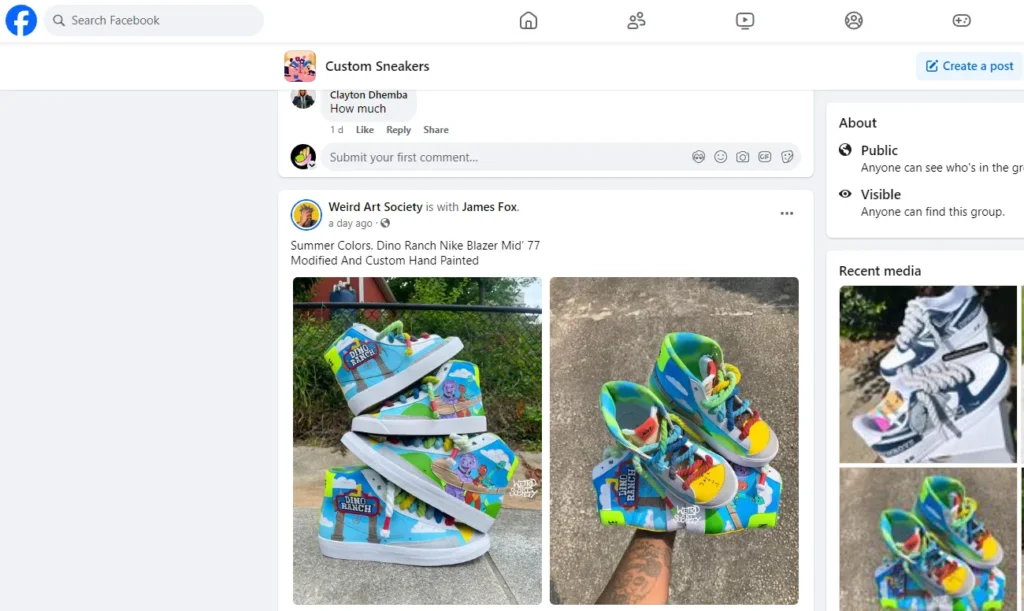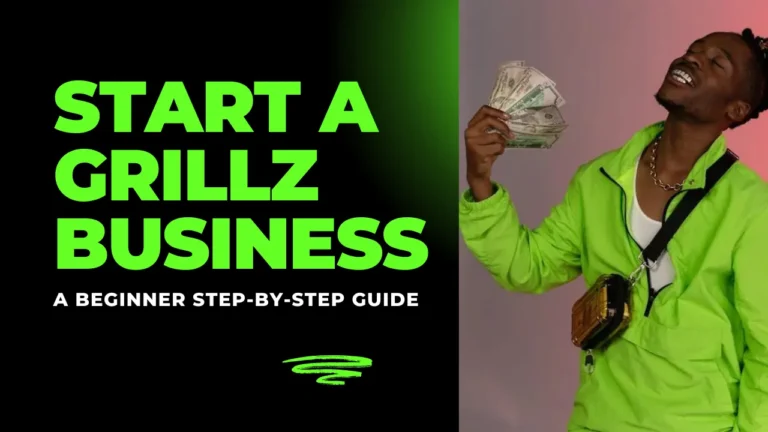Do you have a passion for shoes and a creative vision? Then starting a custom shoe business might be the perfect opportunity for you. Here we guide you how.
With the growing demand for unique footwear, personalized, shifting consumer preferences, and growing customization technologies, it create a path to tap into this market.
The footwear industry is continually evolving.
If you look at the global custom shoe market, the size was valued at US$ 5.03 Bn in 2023, and with an 11.8% CAGR growth rate, it is expected to reach US$10.98 Bn by 2030.

In this in-depth guide, we’ll explain to you how to start a custom shoe business step-by-step. So, follow our guide to launch your business, it provides a clear roadmap.
How to start a custom shoe business?

Requires proper planning, research, dedication, resources and skills, and hard work to make a business successful. Le’ts discuss from research to learning necessary the skills.
1. Research the market
Market research is the primary process of studying the market, competition, demand, consumer preference, popular shoe brands, and industry statistics.
Competitive Research:
Study the competition to learn the strengths and weaknesses of the market by addressing the specific needs of consumers. A SWOT analysis can be helpful for competitive research.
The landscape is competitive, and the custom shoe industry is highly fragmented, with a large number of small and medium-sized enterprises operating in the market.
Some of the key players in the industry include Italian Shoe Factory, Undandy, Nike, PUMA, Vans, Crockett & Jones, Alive Shoes, Edward Green Shoes, and many startups.
Follow the market trends:
Follow the market trend and demand, to attract more and more customers by offering them their desired designs, and stylish customized shoes with various art or paint.
Identify what types of shoes are in more demand in the market such as (running, sports, walking, trekking, and aerobic shoes). Focusing on consumer needs you can prepare your setup.
Research on custom shoes:
For research, you can explore online platforms to gather essential information related to custom shoes (designs, pricing, color, pattern, and customer reviews).
Check online E-commerce platforms (Amazon, eBay, Etsy), where you can find popular designs and custom shoes with details.

Social media research:
Social media platforms (Facebook, Instagram, TikTok, YouTube) are valuable online sources for researching products and market trends.
Many individuals sell custom shoes online on social media, they build an audience base by offering custom designs. If you want to find them, then search using popular hashtags and queries:
- #CustomShoes
- #CustomFootwear
- #CustomSneakers
- #HandmadeShoes
- #BespokeShoes
- #PersonalizedShoes

2. Determine your niche to start.
Choose a niche for your business, it is a strategic decision, that requires proper analysis, personal knowledge, and a good understanding of customer requirements.
The step is an important part of the footwear industry to target a specific market segment that focuses on consumer preferences, such as eco-friendly materials or unique fashion.
You can focus on specific target audiences and their specific needs, which will help to differentiate your service or products from competitors and also build a loyal customer base.
Niche selection:
You can find two types of niches for a custom shoe business one focusing on a broad category and another only focusing on custom shoe painting and art.
Custom shoe business (broad):
Focusing on unique and specific needs, your business can offer various types of customization options to customers.
- Material selection: Leather, canvas, vegan materials shoes, etc.
- Color customization: Design focusing on specific colors for a different part of shoes.
- Design with details: Add unique details like embroidery, patches, or personalized.
- Adjustments: Wider feet, custom insoles, and modification for comfort.
Custom shoe painting and art:
Some individuals or businesses specifically focus on painting custom shoes with their creativity. It is a niche in this business idea.
They make pre-made shoes attractive using paint, markers, dyes, or other mediums. This type of shoe customization requires effort, time, creativity, and proper artistic skills.
There is a good demand for unique, self-customized painted shoes, and they are expensive also.
Other business model:
Production Model:
This focuses on the customization, design, and manufacturing of the shoes themselves.
Wholesale Model: Businesses buy shoes in bulk from manufacturers at a discounted price and then sell them to retailers or individual customers for a profit.
Resale Model: Similar to wholesale, but instead of buying from manufacturers, resellers buy from wholesalers or even directly from other retailers and resell them often at a higher markup.
Print-on-Demand Model: This focuses on design, printing the design on shoes using digital technologies, packaging, marketing, and selling the finished product.
When deciding on your potential niches, consider the size of your target market, the level of competition, your potential profitability, and your ability to offer a unique value proposition.
3. Write a custom shoe business plan.
Business planning is the foundational step of your overall operation, before you start write a plan adding each stage of a startup from setup to managing.
A business plan is a roadmap that helps to structure your business architecture.
Think what are the key elements to add to that plan. Having a strategic plan helps to get funding and build trust, leading investors to confidently invest in your startup.
Developing a business plan is not difficult, understand the basics, and there are no specific rules to write. However, one is a traditional way of business planning and another is the lean startup plan.
Traditional business planning:
- Length: Approximately 20-40 pages.
- Planning: Add Executive summary, market analysis, company presentation, product development, marketing and sales strategies, funding requests, financial projections, and more.
- Time Frame: Long-term fixation, about 3-5 years.
- Description: Detailed analysis and detailed description.
- Purpose: Business plan useful for funds arranging, roadmap/guiding, and long-term plan.
- Audience: Investors, banks, and stakeholders.
Lean startup plan:
- Length of the plan: 1-2 pages.
- Structure: Focus on problem, solution, key concepts, USP, and strategies.
- Time Frame: Mainly the plan focus is short-term.
- Description: Write a high-level overview with short detail.
- Purpose: Founders use the plan for quick testing, and to validate the business ideas, then based on feedback they optimize the service model accordingly.
You can follow business plan templates and read blog post guides to develop your plan.
4. Learn the designing skills
Before starting a custom sneaker business – you need to learn the necessary skills.
If you focus on custom shoe painting or designing only, then learn the design basics.
Here are the skills to learn:
- Artistic skills: Desing, color theory, sketching.
- Technical: Shoe construction, customization techniques (painting, dyeing, distressing, adding embellishments), and basic shoe repair to modify when customizing.
- Business skills: Marketing, sales, customer service, and management.
All those skills you can learn through online resources, workshops, or practicing regularly.
Where to learn the skills?
In the digital era, many options are available for learning any skills. Here are some platforms:
- Design: Online courses (Skillshare, Udemy) or YouTube tutorials.
- Shoe construction: Online courses (Shoemakers Academy) or YouTube tutorials.
- Customization: Find YouTube channels and blogs on shoe customization.
- Business: The SBA website is the best resource to learn overall fundamentals.
Most importantly, you should have a passion for shoes, a creative vision, and a willingness to learn the skills. It requires time, effort, dedication, and regular practice to master shoe painting.
5. Purchase material and supplies
Purchase the best supplies for your custom shoe business, and consider the basic points such as quality, cost, and supplier reputation when buying.
You can search for reputable suppliers online or visit local stores to buy those materials. Before you purchase prepare a list of all equipment, supplies, and materials.
- Material: Paint, preparer, fabric medium, leather dye, finisher.
- Painting kits: Brushes, pens, pallets (to mix the paint), plastic jars.
- Shoes cleaning supplies: Shoe cleaner, leather preparer, soft brush, clean cloth.
- Safety kits: Glasses, gloves, respirator, drop cloth and ventilation.
- Decorative items: Glitter, beads, patches, studs, charms, etc.
Angelus Acrylic Leather Paint
- Angelus Brand Acrylic Paint
- Starter Kit 12 1oz Leather Vinyl
- Works perfectly on any leather surface
2-Soft Fabric Medium
Leather Preparer
4-Coat Finisher
Before you make a purchasing decision – understand the customization process, and properties of each material, and learn material selection, also you can get expert guidance.
Where to buy those supplies?
Online and offline options are available, but important is where you can get at best price and quality. Both options are good, but depending on your needs choose the suitable one.
- Alibaba
- Etsy
- Amazon
- Tandy leather
- Leather supply stores (local or online)
- Shoe components suppliers (local or online)
- Fabric stores (local or online)
- Industrial supply stores (for tools and machinery)
- eBay
We’ve written a complete tutorial on essential shoe customization supplies, follow the guide.
6. Focus on building a brand identity
Choosing a business name is part of branding, so think about how to come up with a unique name.
A name not only helps in branding but is also useful for online presence (social media handles, website domain name, logo), and most importantly it reflects the brand personality.
What matters in business branding:
- Brand name and logo
- Create a brand story
- Visual design: Colors, fonts, and images.
- Brand voice: Communication style.
- Online presence (social media, and website).
- Unique packaging of custom shoes
Carefully choose a business name focusing on different aspects such as branding, legalities (trademark), uniqueness, product focus, etc.
Don’t use trademarked business names that are already used by other brands, find a unique, attractive, short, creative, and user-friendly name.
You can get inspiration from popular shoe brands:
- Nike
- Adidas
- Puma
- Skechers
- Converse
- Reebok
- Crocs
- ASICS
- New Balance

Research and find a name with your creativity, consider using a business name generator tool to simplify the process. Using a keyword like “shoe”, or “sneaker”, you can generate names.
Use your creative mind to create a unique name don’t rely on digital tools, but research is a must.
Before deciding – Research social media handles, and website domains, to check their availability.
You can check the domain availability by visiting Namecheap or Goddady, also can check Google.
You can register the name with the right agencies to protect it. Still depends on specific business needs, however, it is recommended to register with the necessary formalities.
- Entity name: State-level protection
- Trademark: At federal level
- Domain name: Protect Business website address
7. Setup an online store

Decide where you sell your custom shoes, you can sell online or offline, however here we discuss how you can sell online using different platforms.
You can reach a broad target audience by selling at:
eCommerce and online Marketplaces:
Etsy:
- Populat for handmade and custom items.
- Create a shop, and list products with detailed descriptions and photos.
eBay:
- Large, diverse customer base.
- List as auctions or fixed-price; use good photos and keywords.
Amazon Handmade:
- Access to Amazon’s large audience.
- Apply to sell, create listings, and use Amazon’s fulfillment services.
Shopify:
- Full control over branding and customer experience.
- Build a custom online store, handle marketing and sales.
Social Media Platforms:
Instagram:
- Visually driven platform.
- Post quality images/videos using hashtags, and Instagram Shopping.
Facebook Marketplace:
- Large user base, local selling.
- Create listings, join groups, and use Facebook Ads.
Pinterest:
- Drives traffic through inspiration.
- Pin images of your shoes, and link back to your site/shop.
Your own website:
- Full control over the sales process.
- Use platforms like Shopify, Wix, or WordPress; optimize for SEO.
You can combine all the strategies to sell or choose any one when starting, still, it depends on resources, skills, and experience.
Initially, if you focus on one medium to sell your product then this can be more effective to understand the market properly.
You can also increase sales by focusing on various selling strategies.
8. Develop a marketing strategy

Now it’s time to develop a marketing strategy for your business. Use different advertising channels to market your custom shoes. There are numerous ways but ultimately focus on the target market.
Regardless of industry, marketing helps to drive sales and develop a brand image. For developing a solid brand, having a value proposition product, and efficient custom service is vital.
Build your online presence through:
- Social media
- Creating a website
- Optimize for Google search – SEO
- Write blog posts
- Create YouTube turorial
- Create content (articles, videos, reals, infographics, etc).
Don’t waste money on marketing without focusing on the target audience, put your efforts on the right track to attract ideal customers.
Effective marketing strategy:
- Digital marketing
- Influencer marketing
- Run paid ads
- Social media markeitng
- Email marketing
Website:
Create a website that is easy to navigate, accessible, user-friendly, and SEO-friendly.
Add the key information about your business, contact info, shoe designs, product details, buying options, etc. Optimize search engines (Google or Bing) to get organic traffic to your website.
Social media:
Social Media Marketing helps to build an audience base and online presence, also you can sell and promote your custom sneaker or shoe on these platforms (Instagram, Facebook, Pinterest).
Paid Ads:

Advertising your custom shoes using paid ads can be profitable, but depends on your marketing budget. Because paid advertising requires a good amount of money.
You can try this method, if you get good results (sales), then continue. Require research, experiment, optimization, and marketing skills to get the best result.
Here are some places, where you can advertise or run paid ads (Instagram, LinkedIn, Google Adwad, TikTok, Facebook, YouTube, Bing Ads, Pinterest, Amazon Ads, and Google Search Ads.
Shoe business success stories
Starting and running a business is difficult, and making it a successful line requires proper planning.
However many individuals started and are now making good income from this shoe line, with they build their brand by offering custom shoes.
You can read their success stories and get inspiration on how they started, what types of challenges they faced, struggle journey, startup beginnings, and many more.
Here are some examples of shoe businesses, you can explore:
| Name | Founders | Started Year |
|---|---|---|
| Xero Shoes | Lena Phoenix & Steven Sashen | 2009 |
| B Street Shoes | Family-owned | 1990s |
| Atlantis Shoes | Tom Guo | 2010s |
| TANYA HEATH Paris | Tanya Heath | |
| Stonz | Lisa Will | 2004 |
| Creative Souls | Drew McNamara | March 2017 |
One story for example:

In 2009 Xero Shoes began as a passion project for a husband-and-wife duo (Steven Sashen and Lena Phoenix). By inspired simple running, they started designing a simple sandal that mimicked the natural feel of being barefoot with providing protection.
Their journey started from selling an online DIY kit, but their innovative idea for footwear gained popularity and traction among runners and outdoor enthusiasts.
The commitment to natural movement, durability, and affordability helped Xero Shoes grow from a small home-based business to an internationally recognized brand.
Read the complete story – How XERO Shoes was started and is now a recognized brand.
Frequently Asked Questions (FAQs)
Here are some commonly asked queries, see the query and answers.
What is the demand for custom shoes?
The global custom shoes market is profitable, market growing at an 11.8% CAGR growth rate (2023 to 2030). In 2023 market size was valued at 5.03 Billion US dollars and is expected to reach 10.98 US dollars at the end of 2030. Source: Coherent Market Insights
How much does it cost to start a custom shoe business?
Startup costs vary based on your business plan (niche, model, etc.). For painting or basic customization, expect costs for materials, supplies, initial inventory, online store setup (including platform fees), and marketing.
Where to sell custom shoes online?
You can sell custom shoes through your own website (full control over brand), or sell on marketplaces like Etsy, eBay, Amazon, and social media like Instagram or Facebook.
What do I need to make custom shoes?
Making custom shoes is a creative project, you need a few supplies such as Shoes, prep materials (Deglazer, sandpaper, masking tape, clots), painting material (acrylic paint, paint-brush, leather conditioner), finishing (acrylic finisher), decorative elements (that personal).
Bottom line
Starting a custom shoe business creates an accessible path to an entrepreneurship career. Well, follow the given steps to start your custom shoe/sneaker business.
With the right mindset, passion, dedication, and hard work, it is possible to succeed in this field. You can start it both online and offline, analyze the market, and practice designing custom shoes.
If you learned something from this post, you can comment below and share it with your friends. If you have any doubts regarding the shoe business, then comment below.
Related blog posts – You may like:









